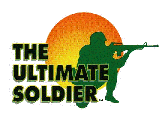- Soldier Movement:
This describes how far each soldier may move. All soldiers start with a maximum of 4 feet which is then modified by the weight of the equipment that they carry (see gear stats), or what position they are in while moving. For example, 4 feet represents your soldier running as fast as he can from one point to the next while dodging bullets. You wouldn't be able to move that fast crawling on your hands and knees. Half the distance for crawling on your hands & knees which is a movement of two feet. Of course, you wouldn't be able to move even that fast if you were lying flat on your stomach using your elbows to drag your body along in a prone position. So movement in this position is one foot. A soldier can always move at least one foot no matter what he is carrying as equipment.
First, soldiers must always move around other soldiers and terrain on the battlefield. This is where the string comes in handy, because it can bend around while still measuring. Second, no unit may move over a terrain piece that represents a building. You may not move over a vehicle, you must move around it. Also, you may not move into destroyed vehicles or vehicles used strictly as terrain pieces.
- Vehicle Movement:
Of course in this game, we're also using vehicles that your troops can ride around in. The rules are all the same as for soldiers except distances of movement, which you can find in the gear stats section.
- Soldier Positioning:
So now some rules on soldier positioning. For example at the beginning of your turn, your soldier had been lying on his stomach in a prone position firing his weapon and now it's his time to move. Since he was lying down, his next turn must only be one foot, but when he gets to the end of his one foot movement, you may reposition him in a kneeling or standing position if you wish more movement in your next turn. So what I'm saying is you can only reposition your soldiers after he has moved. You can check the positioning charts on your rules sheet for any positioning modifiers.
- Movement and the wounded soldier or vehicle:
Due to the fact that a man with a bullet in his side is not going to perform as well as as a guy who doesn't, we have to have a few rules about wounded soldiers. If your soldier has been hit once, with one wound to his toughness, his movement rate is cut in half and his attack modifier for all weapons is at a -1 to his attack dice roll. If he receives two wounds to his toughness score, he can only move a maximum of 1 foot and can fire his weapon from a prone position at a -1 to his attack dice roll. If your soldier has three wounds he can only move a maximum of 1 foot but can no longer fire his weapon. Even though he can't perform any tasks other than crawling, he is still alive for the medic to help. The only exception to this whole thing, is that special forces have a toughness of 4, so they are able to take one hit or one wound without losing any abilities. So basically, he gets one wound free and clear before his abilities become hampered like the standard soldier.
Now a word about wounded vehicles. All vehicles that take damage are still considered to be functioning normally unless half of their toughness score has been exhausted. Only then they lose half of their movement. They are still able to fire weapons though until they are destroyed.
|



